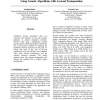Free Online Productivity Tools
i2Speak
i2Symbol
i2OCR
iTex2Img
iWeb2Print
iWeb2Shot
i2Type
iPdf2Split
iPdf2Merge
i2Bopomofo
i2Arabic
i2Style
i2Image
i2PDF
iLatex2Rtf
Sci2ools
GECCO
2000
Springer
2000
Springer
Using Genetic Algorithms with Asexual Transposition
Traditional Genetic Algorithms (GA) use crossover and mutation as the main genetic operators to achieve population diversity. Previous work using a biologically inspired genetic operator called transposition, allowed the GA to reach better solutions by replacing the traditional crossover operators. In this paper we extend that work to the case of asexual reproduction. The GA efficiency was compared when using asexual transposition and the classical crossover operators. The results obtained show that asexual transposition still allowed the modified GA to achieve higher performances.
| Added | 24 Aug 2010 |
| Updated | 24 Aug 2010 |
| Type | Conference |
| Year | 2000 |
| Where | GECCO |
| Authors | Anabela Simões, Ernesto Costa |
Comments (0)

